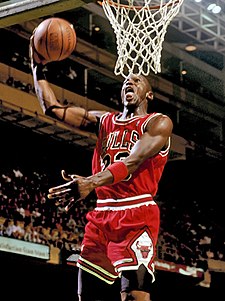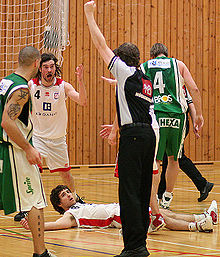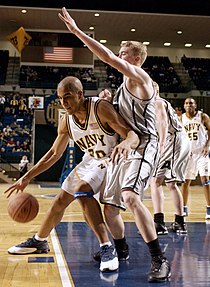| Basketball | |
|---|---|
Basketball is a team sport in which two teams of five players try to score points by throwing or "shooting" a ball through the top of a basketball hoop while following a set of rules. Basketball is one of the most popular and widely viewed sports in the world.
A regulation basketball hoop consists of a rim 18 inches (45.7 cm) in diameter and 10 feet (3.05 m) high mounted to a backboard. A team can score a field goal by shooting the ball through the hoop during regular play. A field goal scores two points for the shooting team if a player is touching or closer to the hoop than the three-point line, and three points (a "3 pointer") if the player is "outside" the three-point line. The team with more points at the end of the game wins, but additional time (overtime) may be issued when the scores of both teams are the same. The ball can be advanced on the court by bouncing it while walking or running (dribbling) or passing it to a teammate. It is a violation (traveling) to walk with the ball (take three steps without bouncing the ball at least once), carry it, or to double dribble (to hold the ball and then resume dribbling).
 Various violations are generally called "fouls". Disruptive physical contact (a personal foul) is penalized, and a free throw is usually awarded to an offensive player if he is fouled while shooting the ball. A technical foul may also be issued when certain infractions occur, most commonly for unsportsmanlike conduct on the part of a player or coach. A technical foul gives the opposing team a free throw.
Various violations are generally called "fouls". Disruptive physical contact (a personal foul) is penalized, and a free throw is usually awarded to an offensive player if he is fouled while shooting the ball. A technical foul may also be issued when certain infractions occur, most commonly for unsportsmanlike conduct on the part of a player or coach. A technical foul gives the opposing team a free throw.Basketball has evolved many commonly used techniques of shooting, passing, and dribbling, as well as specialized player positions and offensive and defensive structures (player positioning) and techniques. Typically, the tallest members of a team will play "center", "small forward", or "power forward" positions, while shorter players or those who possess the best ball handling skills and speed play "point guard" or "shooting guard".
While competitive basketball is carefully regulated, numerous variations of basketball have developed for casual play. Competitive basketball is primarily an indoor sport played on carefully marked and maintained basketball courts, but less regulated variations are often played outdoors in both inner city and rural areas.
Fouls
An attempt to unfairly disadvantage an opponent through physical contact is illegal and is called a foul. These are most commonly committed by defensive players; however, they can be committed by offensive players as well. Players who are fouled either receive the ball to pass inbounds again, or receive one or more free throws if they are fouled in the act of shooting, depending on whether the shot was successful. One point is awarded for making a free throw, which is attempted from a line 15 feet (4.6 m) from the basket.
The referee may use discretion in calling fouls (for example, by considering whether an unfair advantage was gained), sometimes making fouls controversial calls or no-calls. The calling of fouls can vary between games, leagues and even among referees.
A player or coach who shows poor sportsmanship, such as by arguing with a referee or by fighting with another player, can be charged with a more serious foul called a technical foul. The penalty involves free throws (where, unlike a personal foul, the other team can choose any player to shoot) and varies among leagues. Repeated incidents can result in disqualification. Blatant fouls with excessive contact or that are not an attempt to play the ball are called intentional fouls (or flagrant fouls in the NBA). In FIBA, a foul resulting in ejection is called a disqualifying foul, while in leagues other than the NBA, such a foul is referred to as flagrant.
If a team exceeds a certain limit of team fouls in a given period (quarter or half) – four for NBA and international games – the opposing team is awarded one or two free throws on all subsequent non-shooting fouls for that period, the number depending on the league. In the US college and high school games, if a team reaches 7 fouls in a half, the opposing team is awarded one free throw, along with a second shot if the first is made. This is called shooting "one-and-one". If a team exceeds 10 fouls in the half, the opposing team is awarded two free throws on all subsequent fouls for the half.
When a team shoots foul shots, the opponents may not interfere with the shooter, nor may they try to regain possession until the last or potentially last free throw is in the air.
After a team has committed a specified number of fouls, it is said to be "in the penalty". On scoreboards, this is usually signified with an indicator light reading "Bonus" or "Penalty" with an illuminated directional arrow indicating that team is to receive free throws when fouled by the opposing team. (Some scoreboards also indicate the number of fouls committed.)
If a team misses the first shot of a two-shot situation, the opposing team must wait for the completion of the second shot before attempting to reclaim possession of the ball and continuing play.
If a player is fouled while attempting a shot and the shot is unsuccessful, the player is awarded a number of free throws equal to the value of the attempted shot. A player fouled while attempting a regular two-point shot, then, receives two shots. A player fouled while attempting a three-point shot, on the other hand, receives three shots.
If a player is fouled while attempting a shot and the shot is successful, typically the player will be awarded one additional free throw for one point. In combination with a regular shot, this is called a "three-point play" or "four-point play" (or more colloquially, an "and one") because of the basket made at the time of the foul (2 or 3 points) and the additional free throw (1 point).
Shooting
Shooting is the act of attempting to score points by throwing the ball through the basket. Methods can vary with players and situations.
Typically a player faces the basket with both feet facing the basket. A player will then allow the ball to rest on the fingertips of the dominant hand (the shooting arm) slightly above the head, with the other hand supporting the side of the ball. The ball is typically shot by jumping (though not always) and straightening the shooting arm. The shooting arm, fully extended with the wrist fully bent is held stationary for a moment following the release of the ball, known as a follow-through. Players often try to put a steady backspin on the ball to deaden its impact with the rim. The ideal trajectory of the shot is somewhat arguable, but generally coaches recommend a proper arch. Players may shoot directly into the basket or may use the backboard to redirect the ball into the basket.
The two most common shots that use the above described setup are the set shot and the jump shot. The set shot is taken from a standing position, with neither foot leaving the floor, typically used for free throws. The jump shot is taken while in mid-air, when the ball is released near the top of the jump. This provides much greater power and range, and it also allows the player to elevate over the defender. Failure to release the ball before the feet return to the ground is considered a traveling violation.
Another common shot is called the layup. This shot requires the player to be in motion toward the basket, and to "lay" the ball "up" and into the basket, typically off the backboard (the backboard-free, underhand version is called a finger roll). The most crowd-pleasing and typically highest-percentage accuracy shot is the slam dunk, in which the player jumps very high and throws the ball downward, straight through the hoop.
Another shot that is becoming common is the "circus shot." The circus shot is a low-percentage shot that is flipped, heaved, scooped, or flung toward the hoop while the shooter is off-balance, airborne, falling down, and/or facing away from the basket.
A shot that misses both the rim and the backboard completely is referred to as an air ball. A particularly bad shot, or one that only hits the backboard, is jocularly called a brick.
Rebounding
The objective of rebounding is to successfully gain possession of the basketball after a missed field goal or free throw, as it rebounds from the hoop or backboard. This plays a major role in the game, as most possessions end when a team misses a shot. There are two categories of rebounds: offensive rebounds, in which the ball is recovered by the offensive side and does not change possession, and defensive rebounds, in which the defending team gains possession of the loose ball. The majority of rebounds are defensive, as the team on defense tends to be in better position to recover missed shots.Passing
See also: Assist (basketball)
A pass is a method of moving the ball between players. Most passes are accompanied by a step forward to increase power and are followed through with the hands to ensure accuracy.A staple pass is the chest pass. The ball is passed directly from the passer's chest to the receiver's chest. A proper chest pass involves an outward snap of the thumbs to add velocity and leaves the defence little time to react.
Another type of pass is the bounce pass. Here, the passer bounces the ball crisply about two-thirds of the way from his own chest to the receiver. The ball strikes the court and bounces up toward the receiver. The bounce pass takes longer to complete than the chest pass, but it is also harder for the opposing team to intercept (kicking the ball deliberately is a violation). Thus, players often use the bounce pass in crowded moments, or to pass around a defender.
The overhead pass is used to pass the ball over a defender. The ball is released while over the passer's head.
The outlet pass occurs after a team gets a defensive rebound. The next pass after the rebound is the outlet pass.
The crucial aspect of any good pass is it being difficult to intercept. Good passers can pass the ball with great accuracy and they know exactly where each of their other teammates prefers to receive the ball. A special way of doing this is passing the ball without looking at the receiving teammate. This is called a no-look pass.
Another advanced style of passing is the behind-the-back pass which, as the description implies, involves throwing the ball behind the passer's back to a teammate. Although some players can perform such a pass effectively, many coaches discourage no-look or behind-the-back passes, believing them to be difficult to control and more likely to result in turnovers or violations.
Dribbling
Dribbling is the act of bouncing the ball continuously with one hand, and is a requirement for a player to take steps with the ball. To dribble, a player pushes the ball down towards the ground with the fingertips rather than patting it; this ensures greater control.
When dribbling past an opponent, the dribbler should dribble with the hand farthest from the opponent, making it more difficult for the defensive player to get to the ball. It is therefore important for a player to be able to dribble competently with both hands.
Good dribblers (or "ball handlers") tend to bounce the ball low to the ground, reducing the distance of travel of the ball from the floor to the hand, making it more difficult for the defender to "steal" the ball. Good ball handlers frequently dribble behind their backs, between their legs, and switch directions suddenly, making a less predictable dribbling pattern that is more difficult to defend against. This is called a crossover, which is the most effective way to move past defenders while dribbling.
A skilled player can dribble without watching the ball, using the dribbling motion or peripheral vision to keep track of the ball's location. By not having to focus on the ball, a player can look for teammates or scoring opportunities, as well as avoid the danger of having someone steal the ball away from him/her.
Blocking
Block (basketball)
A block is performed when, after a shot is attempted, a defender succeeds in altering the shot by touching the ball. In almost all variants of play, it is illegal to touch the ball after it is in the downward path of its arc; this is known as goaltending. It is also illegal under NBA and Men's NCAA basketball to block a shot after it has touched the backboard, or when any part of the ball is directly above the rim.
To block a shot, a player has to be able to reach a point higher than where the shot is released. Thus, height can be an advantage in blocking. Players who are taller and playing the power forward or center positions generally record more blocks than players who are shorter and playing the guard positions. However, with good timing and a sufficiently high vertical leap, even shorter players can be effective shot blockers.
Height
At the professional level, most male players are above 6 feet 3 inches (1.91 m) and most women above 5 feet 7 inches (1.70 m). Guards, for whom physical coordination and ball-handling skills are crucial, tend to be the smallest players. Almost all forwards in the men's pro leagues are 6 feet 6 inches (1.98 m) or taller. Most centers are over 6 feet 10 inches (2.08 m) tall. According to a survey given to all NBA teams, the average height of all NBA players is just under 6 feet 7 inches (2.01 m), with the average weight being close to 222 pounds (101 kg). The tallest players ever in the NBA were Manute Bol and Gheorghe Mureşan, who were both 7 feet 7 inches (2.31 m) tall. The tallest current NBA player is Yao Ming, who stands at 7 feet 6 inches (2.29 m).
The shortest player ever to play in the NBA is Muggsy Bogues at 5 feet 3 inches (1.60 m). Other short players have thrived at the pro level. Anthony "Spud" Webb was just 5 feet 7 inches (1.70 m) tall, but had a 42-inch (1.07 m) vertical leap, giving him significant height when jumping. The shortest player in the NBA (and second shortest ever in the NBA) as of the 2009–10 season is Earl Boykins at 5 feet 5 inches (1.65 m) .While shorter players are often not very good at defending against shooting, their ability to navigate quickly through crowded areas of the court and steal the ball by reaching low are strengths.




